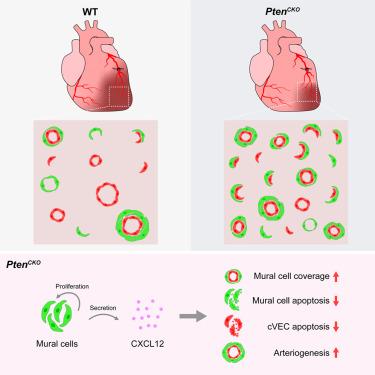Cardiac mural cells are rate-limiting for coronary vascularization after heart injury
IF 4.1
2区 综合性期刊
Q1 MULTIDISCIPLINARY SCIENCES
引用次数: 0
Abstract
Limited angiogenic potential of coronary vascular endothelial cells (cVECs) poses a significant barrier to effective therapeutic revascularization after myocardial infarction (MI). However, the underlying mechanisms of restricted vascularization post-MI remain unclear. Here, we demonstrate that both reduced density and limited proliferation of mural cells result in inadequate mural cell coverage of coronary vessels, consequently impeding coronary vascularization within the MI heart. Our findings reveal that the cell cycle inhibitor phosphatase and tensin homolog (PTEN) is expressed in mural cells from both sham-operated and MI hearts. Conditional Pten deletion in mural cells enhances mural-derived cell (MDC) proliferation, increases coronary vascular density, promotes arteriogenesis, and improves cardiac function following MI. Furthermore, Pten deficiency upregulates chemokine C-X-C motif ligand 12 expression, which potentially reduces apoptosis in cVECs and MDCs and increases vascular density. These results identify cardiac mural cells as promising therapeutic targets for enhancing coronary angiogenesis and vascular remodeling after ischemic injury.

心脏壁细胞是心脏损伤后冠状动脉血管形成的限速细胞
冠状动脉内皮细胞(cVECs)有限的血管生成潜能对心肌梗死(MI)后有效的治疗性血运重建造成了重大障碍。然而,心肌梗死后血管化受限的潜在机制尚不清楚。在这里,我们证明了壁细胞密度降低和增殖受限导致壁细胞覆盖冠状血管不足,从而阻碍了心肌梗死心脏内的冠状血管形成。我们的研究结果表明,细胞周期抑制剂磷酸酶和紧张素同源物(PTEN)在假手术和心肌梗死的壁细胞中都有表达。壁细胞条件性Pten缺失可增强壁源性细胞(MDC)的增殖,增加冠状动脉密度,促进动脉发生,改善心肌梗死后的心功能。此外,Pten缺失可上调趋化因子C-X-C基序配体12的表达,从而可能减少cvec和MDCs的凋亡,增加血管密度。这些结果表明,心脏壁细胞是促进缺血性损伤后冠状动脉血管生成和血管重塑的有希望的治疗靶点。
本文章由计算机程序翻译,如有差异,请以英文原文为准。
求助全文
约1分钟内获得全文
求助全文
来源期刊

iScience
Multidisciplinary-Multidisciplinary
CiteScore
7.20
自引率
1.70%
发文量
1972
审稿时长
6 weeks
期刊介绍:
Science has many big remaining questions. To address them, we will need to work collaboratively and across disciplines. The goal of iScience is to help fuel that type of interdisciplinary thinking. iScience is a new open-access journal from Cell Press that provides a platform for original research in the life, physical, and earth sciences. The primary criterion for publication in iScience is a significant contribution to a relevant field combined with robust results and underlying methodology. The advances appearing in iScience include both fundamental and applied investigations across this interdisciplinary range of topic areas. To support transparency in scientific investigation, we are happy to consider replication studies and papers that describe negative results.
We know you want your work to be published quickly and to be widely visible within your community and beyond. With the strong international reputation of Cell Press behind it, publication in iScience will help your work garner the attention and recognition it merits. Like all Cell Press journals, iScience prioritizes rapid publication. Our editorial team pays special attention to high-quality author service and to efficient, clear-cut decisions based on the information available within the manuscript. iScience taps into the expertise across Cell Press journals and selected partners to inform our editorial decisions and help publish your science in a timely and seamless way.
 求助内容:
求助内容: 应助结果提醒方式:
应助结果提醒方式:


